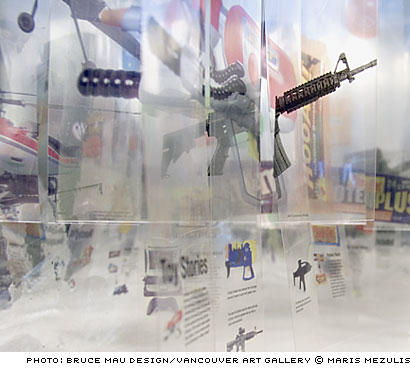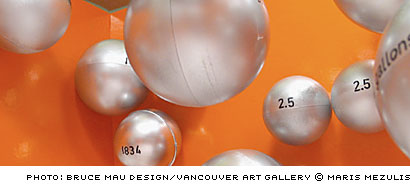Having completed the first floor of the exhibit on the one day, I returned the next morning, fresh and alert, to report on the 2nd half, upstairs in the gallery.
I was faced, at the entrance to the upper floor, by flourescent yellow walls. Things are a little different up here and aesthetics are very much back in action. I explored a display of technology-enhanced materials, each one announcing itself in a unique typeface or letterform cut from or into the material. Due to a heightened sensitivity to technology and a freak of acoustics I did, at one point think that a strand of glow-tape might be talking to me. It wasn’t. I’m pretty sure.
The “superhero” substances range from actual fabrics for wetsuits, fire suits and khaki pants (including the infamous-in-my-household “Nanotextiles” which Dante bought and declared to be the hottest (as in sweaty and uncomfortable) pants he’s ever owned) to self-cleaning glass, bamboo laminates, various foams and insulations, vegetable-based polymers and of course the famous Aerogel, which is currently used to trap comet dust and has a whole other future as potential insulation or windows mapped out for it here on planet earth.
Most of these substances are extremely cool. Many of them are environmentally responsible, use recycled materials and either break down or don’t break down as required. They hold not only obvious design in their existence, but intriguing potential as design materials.
Here’s where Bruce and I went our separate ways due to a complete failure to understand each other. Here, in the room of silver-lined walls and 20-foot banners. Here, where we marvel at the similarities in technology of the assault rifle and the toy, the Super Soaker. Right here, where we see the optimism in the products and technological advantages that we as consumers and 21st century humans experience as a direct spin off (or “spin on” as Massive Change likes to say) of military spending.

I’ve given this a lot of thought, and I’m really not sure if my objections are knee-jerk anti-militarism or not. It just seems to me that this rampant optimism has gone too far here. That the determination to focus on the good has taken a turn down a very dark corridor, and I for one am having some trouble finding my way by this flickering little glow of light. At what cost the lightweight dried food rations, the Gore-tex, the camelbacks, remote controls, GPS and internet? Without the military spending on exploring these materials, robotics and communication systems developed to aid in the efficient destruction of people (oh, excuse me, “protection” of people) we would have none of these things. Or would we? So we reap the chaff of the military wheat. It really makes you wonder what would be possible if we could have the whole harvest.
This section also explores the reverse transfer of ideas and technology from consumer product design to the military as well, for instance “the transformation of Tyco’s remote-controlled ‘Vertigo’ toy truck into a remote-controlled military spy weapon called ‘Dragon Runner’” [text from the press kit]. I’m just not sure if that makes it better, or worse.
As I leave this room a horde of school children are tugging at banners 6 times their height and walking into silver walls. Bump, “Ouch.” Ouch, indeed.
If you were at the 2003 AIGA conference in Vancouver, the term “cradle to cradle” design will already be familiar to you. Not to trivialize it, but also not to retread this much-covered ground: recycling, reusing, biodegradability, vegetable-based materials for e.g. food takeaway, compostable materials … you know the drill. Recyclable materials hang from the ceiling like popcorn strings, and various artefacts are displayed on a slab. (Of note, A Sound Wave Freezer: “surprisingly quiet thermo-acoustic uses sound waves at a deafening level of 173 decibels.” Nice.)

Humourously, one of the first artefacts in this section is an artificial nose, which makes me think immediately of Peter Sellers. After a display of the various technological devices that may be implanted in our bodies to keep us alive or functioning, are a series of voting booths. At each booth there is a stated issue, such as “Working with the basic elements of life” followed by a list of “hopes” and “fears” (each one balanced, by column). The question “Should we be doing this?” sits above 2 clear plexiglass boxes—“YES”, “NO”—and slips of yellow paper available for our “vote.”
Although most of the hopes and fears seemed to be fairly balanced from viewpoint as well as graphically, some of the stated questions were loaded. For example “Increasing Access to Good Health” is about bioengineering. “Changing the way we feed the world” is about genetically modified crops. In both instances the “fears” touch on some of the negative aspects, but the issue itself is presented as beneficial.
Here, as elsewhere, the thinking seems a little … well, not well thought out. Under “Engineering animals” one of the “hopes” is to increase disease resistance, and therefor possibly avoid e.g. mad cow disease. Well, that disease was caused by the unwise practice of feeding animal parts, among other things, to cows. To think that you can design animals to an extent that human intervention in their lives (i.e. how we treat them, feed them and process their meat) will no longer have an effect on their health (and ours) is both ludicrous and shocking.
It is, in fact, in the living economies section that an assumption of the world and the mini-universes within that world as subservient to man becomes most evident. Later, from the press kit, the words “one complex network of dominance over nature” and “[nature’s] absolute control continues to elude us,” jump out at me.
Most of the issues here are extremely complex, and for them to be parceled out to us in these easily digestible wafers of information seems to be bordering on irresponsible.
The voting makes us feel good (and the pieces of bright yellow paper look good in their plexiglass boxes), but there’s nothing to prevent us from dropping multiple slips into whichever box, and I find it very hard to believe that they will ever be counted or put to any specific use. When is a vote not a vote? Well, when it’s an untabulated slip of yellow paper in a box. That, my dears, is poor and misleading design.
Design-wise, this would have been a good use for the bar-code card, with each voting box equipped with a counter that reads the barcode only once (but maybe only if there were a 3rd box that said “I am not qualified to make an informed decision on this issue.”). When I think about the concept of using a barcode card to turn something on, and then using handfuls of yellow paper to “vote” … there’s just something so incredibly upside down and backwards to that that really, what can you do but laugh?
Is it deliberate that in the section that deals with our traditional understanding of “economy” they drop the use of the word “economies”? Anyway, this is a fairly large room with the walls painted flourescent red, printed with statistics, and with large silver, inflatable balls hanging from the ceiling. The balls seem to represent some of the statistics but if they bear any relationship to each other or in some way represent their own collection of data, that is extremely unclear. There are seats. I sat down. I was tired. I contemplated the walls and wondered if flourescent paint is particularly bad for the environment.

This is the last exhibit room, and I was nearly done.
: :
Read Part 4 of Massive Post or Part 1 or Part 2






it's funny, the first time i heard about bruce mau and his redesigning guatemala and other such overwhelming projects, i thought good for him. he's really doing something interesting. but now, he's starting to feel a little... well...dr. evil to me. why is his vision of the world the right one?
it seems like his understanding of design is being used to design your choices that what he's up to is good and right. i am almost certain not once in the military technologies section does it have any statistics regarding the lives lost due to military action. what is the cost of these innovations?
this seems like a wierd path to explore. he wants us to be a global community, yet he's saying look at all the great things we came up with to kill each other. and if military action is responsible for these innovations, then accordingly war is great for humanity, cause we'll get even more great stuff? dr. evil indeed!
On Oct.18.2004 at 10:41 AM